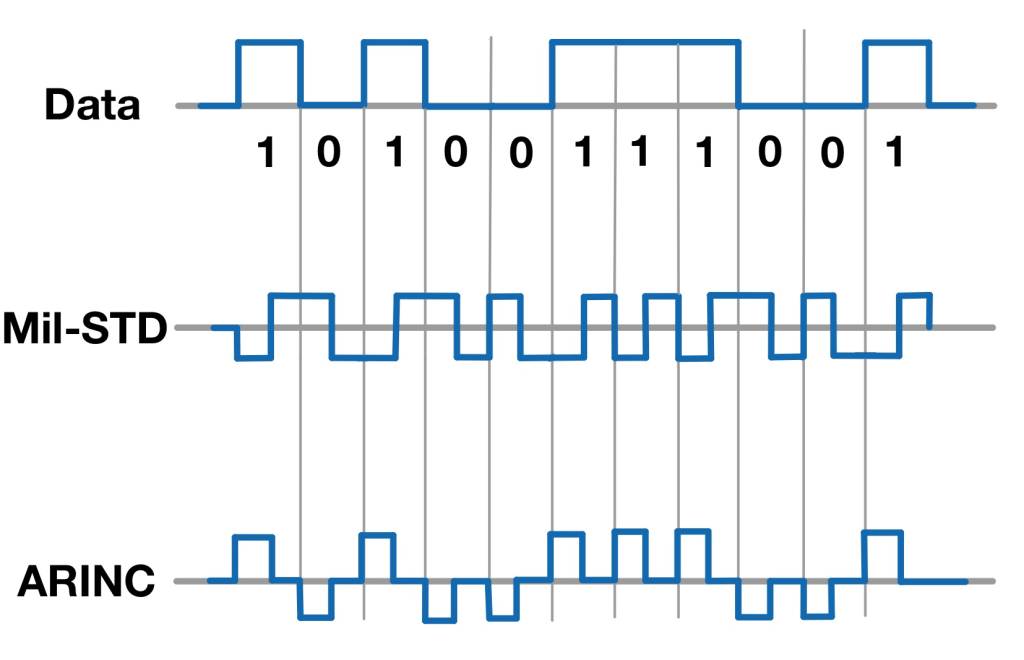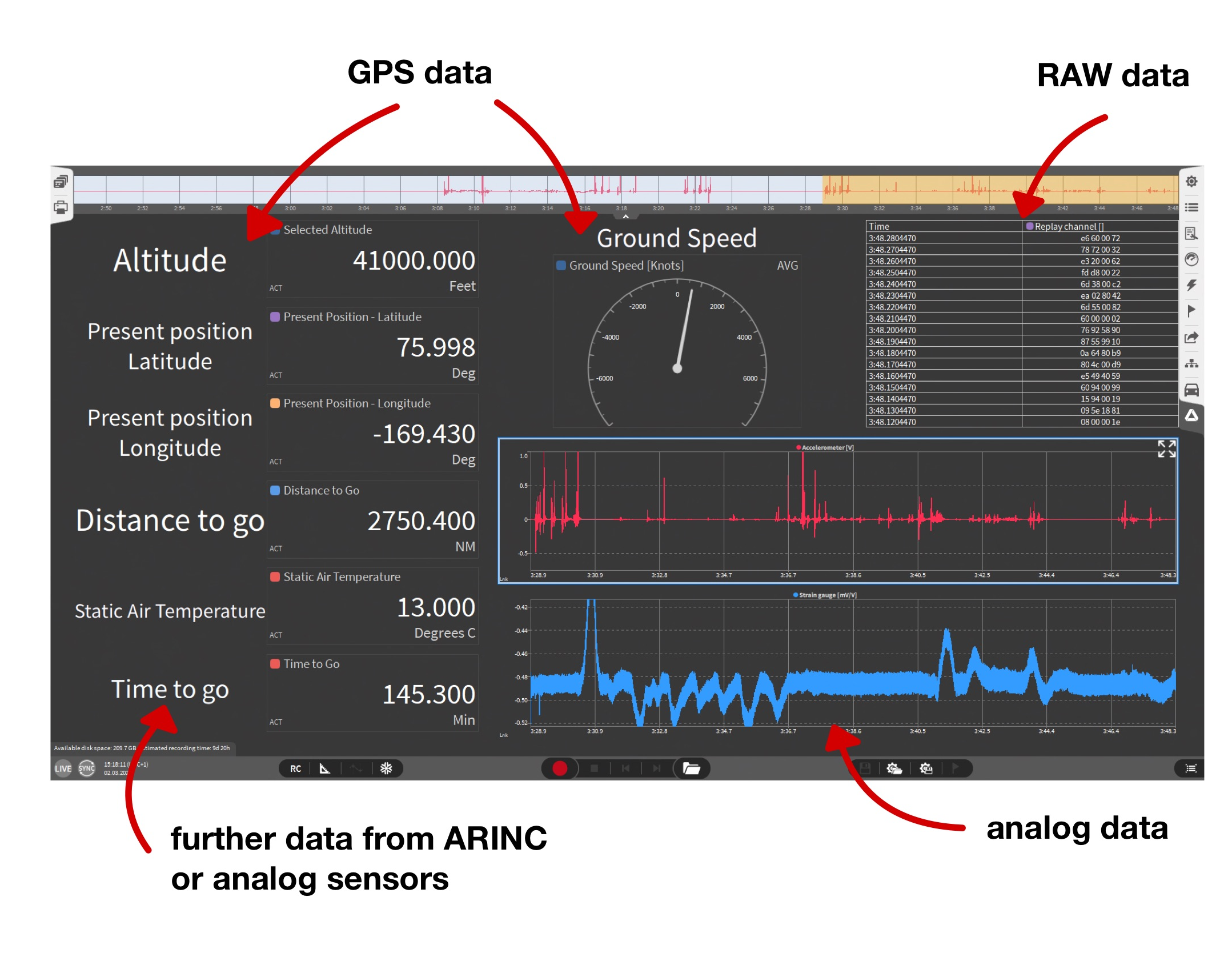ARINC 429 and MIL-STD-1553

Aerospace engineering has always been one of the most complex and versatile fields of engineering. Not only does it require sophisticated technology to get aircrafts or satellites into the air, but passenger safety is also of greatest importance. It is therefore not surprising that these industries have established their own standards – ARINC 429 and MIL-STD-1553. If you want to learn more about these standards and their implementation at DEWETRON, you are at the right place.
What is ARINC 429?
In short, ARINC 429 is a bus standard for avionics systems. Avionics is a collective term for all electrotechnical systems in airplanes or space travel. Most commercial aircrafts (cargo or passenger airplanes) use ARINC 429, but there is also a light variant, which private or sports aircrafts use.
The main characteristic of ARINC 429 is its high reliability. One reason for this is the way in which information transmission takes place. While in conventional systems a bit is transmitted by defining two voltage levels (high and low), ARINC 429 defines three levels. Thus, it is possible for each bit to contain synchronization information. This is not possible in conventional systems, where there must always be a separate start and stop bit for synchronization.
Another special feature of ARINC 429 is the definition of so-called labels. Labels specify the properties of individual components. For example, an aircraft may contain various systems such as altimeters, on-board computers, etc. Labels define basic properties of these devices and ensure a certain interchangeability of the components.
What is MIL-STD-1553?
Aerospace or military applications less frequently use the ARINC 429 bus. Instead, MIL-STD-1553 has established itself as the bus standard, offering above all a higher transmission rate.
Also the MIL-STD-1553 standard does not need a separate start and stop bit. There, one solves the synchronization problem in a different way than for ARINC 429. MIL-STD-1553 defines only two voltage levels, where each bit consists of an up and a down signal. The combination up-down represents the 0 and down-up the 1. The graphic below compares the decoding scheme of MIL-STD-1553 and ARINC 429.

Decoding of bits in ARINC 429 and MIL-STD-1553
Due to this special type of decoding, it is possible to increase the interference resistance even further. Therefore, one uses a galvanic isolation of the individual system components from the mains. This means that no current can flow between two circuits between which information is to be exchanged.
OXYGEN’s avionics features
OXYGEN is a software for data evaluation and analysis developed by DEWETRON. Starting with version 5.3 OXYGEN also supports the ARINC 429 standard and offers a wide range of functions:
- You can receive RAW data, display it, and perform both online and offline decoding. The difference between online and offline decoding is explained here.
- The baud rate and parity of the data can be specified.
- A standard library is available without further installation. This includes equipment IDs and labels.
- It is possible to choose between 4 and 16 channel setups.
- Various settings are available to edit labels and save setup files.
- You can export ARINC signals in many different formats. A listing can be found in our OXYGEN online manual.
- …
However, we did not mention the most important feature of OXYGEN yet: OXYGEN’s ease of use. Not only is the interface intuitive and designed for both touch and mouse input, OXYGEN also offers you the possibility to customize your measurement screen. You can, for instance, combine analog data from a camera or a strain gauge with ARINC data – just as you wish. Below, you can see an example of how such a measurement screen could look like:

OXYGEN measurement screen for avionic data
You can find even more information about the implementation of ARINC in OXYGEN in our ARINC 429 technical reference manual, which is available for download here:
DOWNLOAD ARINC 429 TECHNICAL-REFERENCE-MANUAL
Furthermore, MIL-STD-1553 is supported from OXYGEN 5.4 onwards, introducing hardware support for Altadt MIL-1553 boards, so you can receive and decode data. In addition, all functions of our comprehensive OXYGEN software are of course available. You can get an insight into the functionality of OXYGEN here.
DEWETRON’s avionics hardware
People do not only recognize DEWETRON for the intuitive OXYGEN software, but also for the outstanding hardware we provide. Thus, we offer a wide range of measurement and test systems, which are not only reliable but also highly modular.
For example, our DEWE2-A4 and DEWE3-A4 all-in-one systems are ideal for mobile use. They combine a modular, customizable design with a full HD multi-touch display. In combination with our TRION-ARINC and TRION-MIL1533 DAQ boards, this results in a competent system for any avionics application. Of course, when purchasing such a system, OXYGEN with included ARINC or MIL-1533 option is already on your device.
More information about all our products can also be found on our DEWETRON website. Whitepapers, video tutorials or further blogposts are available in our DEWETRON Academy. Also, we are regularly active on LinkedIn and YouTube. So, if you do not want to miss any new information, follow us there.
*** Visit us at the PCIM in Nuremberg at booth 6-243 and see live OXYGEN and our data acquisition systems. Contact us for your free ticket ***





